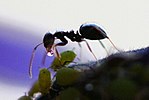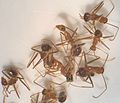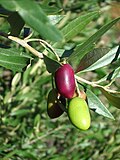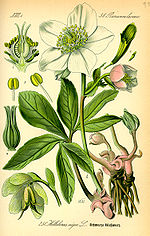Sooty mold (also spelled sooty mould) is a collective term for different Ascomycete fungi, which includes many genera, commonly Cladosporium and Alternaria...
8 KB (906 words) - 01:27, 4 June 2024
honeydew almost right onto the snout of the gecko. Honeydew can cause sooty mold on many ornamental plants. It also contaminates vehicles parked beneath...
13 KB (1,590 words) - 23:21, 17 July 2024
subnudus sooty mold (Leptoxyphium sp.) Macrophomina phaseolina (syn. Macrophomina phaseoli) thread blight (Marasmiellus scandens) black mildew, sooty mould...
29 KB (2,136 words) - 06:19, 9 June 2024
aphids produce a sticky substance known as honeydew, which can lead to sooty mold on the plant. Woolly aphids generally are not much cause for alarm, although...
7 KB (614 words) - 19:42, 2 August 2023
Capnodium footii is a sooty mold that develops in coconut leaves. Naqvi, S. A. M. H. Diseases of fruits and vegetables: diagnosis and management. New York:...
1 KB (40 words) - 16:08, 10 January 2024
These bugs also exude honey dew over the mango tree leaves, on which sooty mold fungus develops reducing the photosynthetic efficiency of the tree. It...
3 KB (360 words) - 09:44, 8 April 2024
on sap. The excess fluid they imbibe is secreted as honeydew on which sooty mold tends to grow. The insects often have a mutualistic relationship with...
46 KB (4,739 words) - 22:54, 10 July 2024
Scorias spongiosa is a sooty mold fungus that grows on aphid honeydew. It is a member of the Capnodiaceae family of ascomycete fungi. It is found only...
5 KB (481 words) - 08:58, 21 February 2024
Sooty blotch and flyspeck (SBFS) or apple summer disease is a plant disease caused by a complex of saprophytic fungi which colonize the epicuticular wax...
12 KB (1,426 words) - 03:55, 11 July 2024
Capnodium ramosum is sooty mold widespread in India that affects mangos. Honeydew secreted by aphids and other insects attracts the mold, making it quickly...
738 bytes (46 words) - 04:08, 19 April 2024
greening disease. M. paniculata is vulnerable to soil nematodes, scales, sooty mold and whiteflies. Flowers and leaves Line drawing showing flowers and fruit...
12 KB (1,011 words) - 03:28, 18 May 2024
initially based on the family Capnodiaceae, also known as sooty mold fungi. Sooty molds grow as epiphytes, forming masses of black cells on plant leaves...
6 KB (382 words) - 06:18, 10 January 2024
serious harm to otherwise healthy trees. Below these colonies, deposits of sooty mold develop caused by the fungus Scorias spongiosa growing saprophytically...
20 KB (2,157 words) - 15:17, 15 April 2024
Nectria foliicola Mycosphaerella musicola Pseudocercospora musae [anamorph] Sooty mold Limacinula tenuis Speckle Mycosphaerella musae Squirter (black end disease)...
9 KB (44 words) - 16:09, 22 May 2024
this species being referred to as the "Boogie-Woogie Aphid". Deposits of sooty mold caused by the fungus Scorias spongiosa build up below the colonies, growing...
4 KB (380 words) - 00:59, 1 June 2023
margins. Black beech is known as black beech because it is prone to a sooty mold which covers the trunk and branches. This, in turn, is the result of a...
4 KB (371 words) - 17:20, 26 October 2023
adults are found on sooty mold growing on Nothofagus trees. Gut contents indicate that at least adult Agapytho consume the sooty mould as part of their...
3 KB (255 words) - 15:57, 2 October 2022
not eaten by the ants drips onto the trees and encourages the growth of sooty mold over the leaves and stems. This gives plants an ugly black appearance...
25 KB (3,039 words) - 00:07, 11 July 2024
sooty mold and sooty beech scale. It has been hypothesized that the larvae feed on sooty beech scale. However, they may also feed on the sooty mold itself...
8 KB (876 words) - 03:42, 29 January 2024
out plant sap, depleting the strength of the plant. They can also cause sooty mold along with their fluffy white wax, detracting from the plants' appearance...
6 KB (798 words) - 22:15, 25 May 2024
amounts of honeydew that support unsightly or harmful infestations of sooty mold. Recent studies suggest that insecticides can also be excreted through...
31 KB (3,587 words) - 19:55, 17 June 2024
damage from sap sucking, the insects also secrete honeydew, on which sooty mold often grows and causes further damage to the host plant. Some ants will...
11 KB (1,149 words) - 08:57, 18 June 2024
Capnodium is a genus of sooty molds in the family Capnodiaceae. It was circumscribed in 1849 by French mycologist Camille Montagne with Capnodium salicinum...
5 KB (278 words) - 20:01, 8 April 2022
Aspergillus niger (category Molds used in food production)
plant to perish before maturation. Specifically, Aspergillus niger causes sooty mold on onions and ornamental plants.[citation needed] A. niger is pathogenic...
34 KB (3,551 words) - 10:03, 12 July 2024
pollinators. It is vulnerable to certain pests, including the olive fruit fly, sooty mold and Verticillium dahliae. On the other hand, it has a moderately good...
6 KB (569 words) - 01:30, 14 March 2023
original on 2015-04-02. Retrieved 2015-04-26. Gillman, Daniel H. (2005). "Sooty mold" (PDF). University of Massachusetts Amherst. Archived (PDF) from the original...
103 KB (11,245 words) - 12:03, 23 June 2024
hellebores, coating them with a honeydew that can lead to the growth of sooty mold on the leaves and flowers of the hellebore. This species of aphid only...
48 KB (4,126 words) - 00:27, 8 May 2024
Their feeding produces honeydew, which can lead to the growth of black sooty mold. "Oak Lecanium Scale (Parthenolecanium quercifex)". iNaturalist. Retrieved...
3 KB (315 words) - 21:01, 16 March 2024
Rumple of lemon fruit Unknown Shell bark complex Unknown - (viroid?) Sooty mold (superficial, not pathogenic) Capnodium C. citricola Capnodium sp. Stem-end...
12 KB (18 words) - 22:31, 5 November 2023
(Schwein.) Fr., have been recorded on Onoclea sensibilis, where their sooty mold buildup impairs leaf function. Onoclea sensibilis can host Burkholderia...
31 KB (2,865 words) - 00:31, 4 December 2023

























